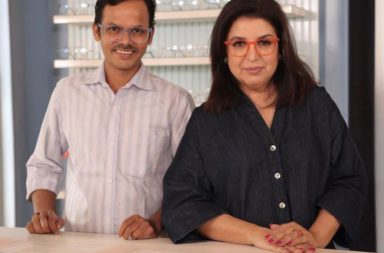Aye Halo: Revel in the festive fervour of Navratri as we share stories about history, food, music, fashion & much more.
Navratri, a vibrant and spiritually significant festival celebrated by millions of Hindus across India and around the world, is a grand spectacle of devotion, dance, and cultural diversity. It spans nine nights, during which devotees honour the Goddess Durga and her nine forms, celebrating her victorious battles against evil. Navratri’s festive spirit encapsulates rich history, mythology, and an enduring spiritual legacy that holds its devotees in awe.

The Mythological Origin
Navratri‘s roots can be traced back to various ancient texts and legends, but one of the most revered stories is the battle between the demon king Mahishasura and the mighty Goddess Durga. The story goes that Mahishasura was granted a boon by Lord Brahma, which made him nearly invincible. With this newfound power, he began a reign of terror, threatening both the heavens and the Earth. The gods, unable to defeat him, sought the help of the divine mother, Durga.

Pngtree
Goddess Durga’s Nine Forms
Goddess Durga, the divine warrior, is believed to have nine forms, each possessing unique qualities and attributes, which are invoked during the nine nights of Navratri:
Shailaputri: The first form of Goddess Durga is Shailaputri, who is the daughter of the Himalayas. She is depicted riding a bull and carries a trident. Her worship symbolises the removal of ignorance and the beginning of spiritual awakening.
Brahmacharini: The second form is Brahmacharini, who embodies penance and knowledge. She carries a rosary and a water pot and is often depicted in white. Devotees seek her blessings for inner strength and wisdom.
Also Read: Walk-In The Wardrobes Of Music Sensations With Rani Ko-HE-Nur
Chandraghanta: The third form, Chandraghanta, is a fierce goddess who has a crescent moon on her forehead and rides a tiger. She is worshipped for her courage and grace.
Kushmanda: The fourth form, Kushmanda, is believed to create the universe with her smile. She has eight arms and holds various weapons and rosaries. Devotees seek her blessings for prosperity and well-being.

Skandamata: Skandamata is the fifth form, representing motherly love and protection. She holds her son, Lord Skanda, and is worshipped for the welfare of children and family.
Katyayani: The sixth form, Katyayani, is a fierce warrior with four arms. She is invoked to remove obstacles and protect her devotees from harm.
Kalaratri: Kalaratri, the seventh form, is a dark and fierce goddess who destroys ignorance and negativity. Her worship symbolises the triumph of light over darkness.
Mahagauri: The eighth form, Mahagauri, is the epitome of purity and peace. She is depicted in white and rides a bull. Devotees seek her blessings for inner and outer purification.
Siddhidatri: The ninth and final form, Siddhidatri, is the giver of supernatural powers and blessings. She is often depicted with four arms and bestows her devotees with wisdom and knowledge.
Navratri Celebrations
During the nine nights of Navratri, devotees celebrate these divine forms through various rituals and traditions. Homes and temples are beautifully decorated, and people often fast during this period. The evenings come alive with enchanting Garba and Dandiya Raas dances, where people dress in colourful attire and create a mesmerising spectacle of rhythm and movement. Social media is flooded with pictures of these social gatherings, where people put their best foot forward. Navratri’s pandals are frequented by celebrities, creating a fun atmosphere.

Drikpanchang
Navratri is a celebration of devotion, spirituality, and cultural diversity, and it showcases the enduring power and grace of Goddess Durga and her nine forms. Navratri’s mythology and history remind us of the eternal battle between good and evil and the ultimate triumph of light over darkness. This festival is a testament to the enduring faith and devotion of millions who come together to celebrate the divine goddess, seeking her blessings for prosperity, protection, and spiritual enlightenment.


